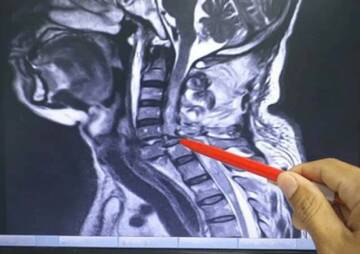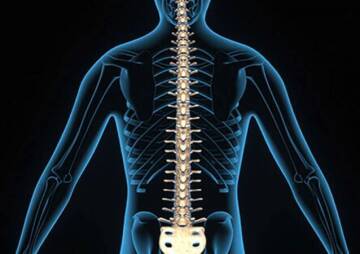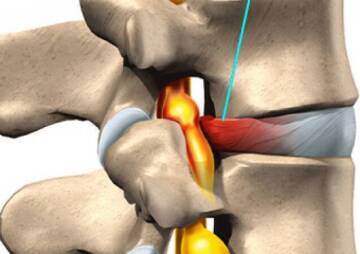-
فئة
Craniomaxillofacial Surgery
Orthopedic Surgery
Spine Surgery
Orthopedic Implants
Hip Surgery
Knee Surgery
Pectus Excavatum
Bone Graft
Disinfectants
Healthcare
The treatment of cervical spine injury

The cervical spine is located at the top of the spinal column. The cervical spine injuries are very uncommon and can result in significant long-term disabilities.
The cervical spine is located at the top of the spinal column. The cervical spine injuries are very uncommon and can result in significant long-term disabilities. It is surrounded by seven vertebrae and acts as a protection to the spinal cord of an individual. The most common cervical spine injury symptoms that a patient is more likely to experience are inability to breathe without assistance, inability to speak, numbness and loss of feeling right below the injured area, paralysis in the legs, and inability to control bowel function and to dress oneself.
The unfortunate truth that is behind the spinal cord injury is that there is no way to countermand the damage caused to the spinal cord at any level. Cervical spinal cord injury is one of the most severe and serious of all the spine injuries, and there is a long road for the patient to recover from it.
There are early treatments for this type of injury that include stabilizing the neck and preventing from further damages and injuries, regulating the breathing function, and preventing complications such as blood clots and urine retention. A patient who is suffering from cervical spine injury will need to have a good level of mental health as it directly relates to physical health. The spinal cord is sending messages to all parts of the body from the brain. An individual is able to feel pain because the messages are being sent from the spinal cord. If the injury is closer to the neck, then there can be paralysis and severe pain. There is no way to undo the damage that has been caused to the spinal cord, but researchers are working hard to find new treatments that include prostheses and generation of nerve cells.
During the early stages of the treatment, medical attention is critical to minimize the effects of neck and head trauma. In the emergency rooms, doctors try to focus more on maintaining the patient’s ability to keep breathing and preventing from getting shocks or heart attacks. The patient with a spinal cord injury will be under intensive care for treatment. After the initial days, when the injury stabilizes, the doctors put their attention on preventing secondary problems that might arise, such as pressure ulcers, infections, blood clots, and muscle contractures.
There is nothing to worry about as the new technology has given us devices to help the patient feel more comfortable. With the modern wheelchairs, people who are suffering from spinal cord injuries are more active. In other cases, for a patient who has a limited function in the hand, computer adaptation is done. These adaptations are very powerful tools and can range from simple to complex. Examples include key guards and voice recognitions. In the cases, where the patient has problem walking, the robotic gait training allows the patient to walk after the spine injury. The recovery after the spinal cord injury may take weeks up to approximately six months. It depends on the injury and the person - in some cases it took six months and some cases the patients showed small improvements after up to one to two years.
Traumatic Cervical Spinal Cord Injury
The injury often causes permanent changes in the strength of the patient, sensation, and other body functions below the area of the injury. The ability to control the limbs after the cervical spine injury highly depends on two factors: the place of the injury and the severity of the injury caused to the spinal cord. The emergency signs and symptoms of a spinal cord include extreme back pain, pressure in the neck, difficulty in walking, oddly positioned and deformed neck or back. The spinal cord injuries are results of damage caused to the vertebrae, ligaments and disc. A traumatic spine injury may be caused by arthritis, cancer, infection, and degeneration of the spine.
Common Causes of The Spinal Cord Injuries
Common causes of the spinal cord injuries are as follows:
Falls: After the age of 65, the most causes of spinal cord injury occur due to falls. Over all spinal cord injuries, falls account for 31%.
Sports and recreation injuries: Athletic activities count for 10% of spinal cord injuries.
Alcohol: In about one out of four spinal injuries is due to alcohol.
Diseases: Diseases such as cancer, osteoporosis, and arthritis are other causes of spinal cord injury.
A cervical spinal injury might give rise to circulatory problems, which range from low blood pressure when the person rises, to swelling of the extremities. The circulations may change or even increase the risk of developing blood clots and pulmonary embolus.
Spine Injury Risk Factors
The spinal cord injury is the result of an accident and it can happen to anyone. Other factors that have a high risk of this injury include:
Being male: A disproportionate number of men have been affected with spine injury. Females have accounted for only 20% of traumatic spinal cord injury in the United States.
Being between the age of 16 and 30: A person between the age of 16 and 30 is more likely to suffer from traumatic spinal cord injury.
Engaging in risky behavior: Diving or playing sports without wearing the proper protections and safety gear can lead to spinal cord injuries. The leading cause of injury nowadays is the motor vehicle injury for people under the age of 65.
Having a bone or a joint disorder: A minor injury can be the result of a spinal cord injury if the person has another disorder that effects the bones or joints, such as arthritis.
Preventing Cervical Spinal Injury
The following pieces of advice might reduce the risk of the spinal injury.
Driving safely: One of the most common cases of such injuries are car accidents. Wear a seat belt every time driving your car.
Check pool’s depth before diving in: Make sure the pool is deep and not shallow. Don’t dive into a pool which is above the ground and you don’t know its depth.
Avoid drinking and driving: Don’t drive when you are intoxicated or under the effect of drugs. Avoid getting into cars where the driver has been drinking.
Symptoms of Spinal Cord Injury
The spinal cord injury has the following symptoms:
- Problem while walking
- Loss of bladder control
- Problem in moving the hands and legs
- Numbness and tingling in the extremities
- Headaches
- Pressure and stiffness in the neck and back.
- Abnormal positioning of the head
Neck Fracture Treatment
The other name for neck fracture is “cervical fracture,” which is a break in one or more of the seven cervical bones in the spine.
The neck fracture is caused by trauma to the neck, which is so strong that can break the vertebra. Such trauma can be caused by falls, car accidents, severe twist to the neck, and blows to the head and neck area. The factors that increase the risk of the neck fracture can be advance aging, osteoporosis, decreased mass in the muscle, and violence.
The treatment option in the case of minor neck fracture includes using of neck collar or brace, which is used in the insignificant neck cases and stays on up to 8 months. It allows a minimal movement only, and surgery using plates and wires to connect the fractured bones and hold them in their respective places in order to heal. Over all the duration of the recovery depends on the type of the injury, whether it is a permanent or a minor injury. A fractured neck may result in the person being admitted in the hospital for days and even weeks, though the period may even get expended depending on the fracture type and the surgery. If the fracture is minor and the spine is intact, in some cases, the patients can wear braces and, with the advice of the doctor, rest and recover at home. The patient can take pain relief medicine to calm the pain, attend physio therapy, use pillow with a proper height, and apply cold pack in order to help with the swelling.
Spinal cord and neck are very delicate and they play a very important role in our life. The spinal cord is the sender of the messages to the body parts and it allows the individual to move. Actions that are dangerous and may cause damage and fracture to the spinal cord and neck should be avoided. There is no guarantee as to when the patient will recover since it highly depends on the severity of the fracture and the area. Spinal cord injuries are of two types, one with paralysis of the lower body, which is called paraplegia, and the other type with paralysis below the neck, which includes arms and legs and is called quadriplegia.
Detailed information about the spinal cord injury, as well as neck injury, can be found on Health News Center website and is available for all.
References: mayoclinic, uvahealth






